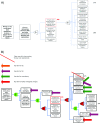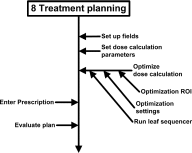The report of Task Group 100 of the AAPM: Application of risk analysis methods to radiation therapy quality management
- PMID: 27370140
- PMCID: PMC4985013
- DOI: 10.1118/1.4947547
The report of Task Group 100 of the AAPM: Application of risk analysis methods to radiation therapy quality management
Abstract
The increasing complexity of modern radiation therapy planning and delivery challenges traditional prescriptive quality management (QM) methods, such as many of those included in guidelines published by organizations such as the AAPM, ASTRO, ACR, ESTRO, and IAEA. These prescriptive guidelines have traditionally focused on monitoring all aspects of the functional performance of radiotherapy (RT) equipment by comparing parameters against tolerances set at strict but achievable values. Many errors that occur in radiation oncology are not due to failures in devices and software; rather they are failures in workflow and process. A systematic understanding of the likelihood and clinical impact of possible failures throughout a course of radiotherapy is needed to direct limit QM resources efficiently to produce maximum safety and quality of patient care. Task Group 100 of the AAPM has taken a broad view of these issues and has developed a framework for designing QM activities, based on estimates of the probability of identified failures and their clinical outcome through the RT planning and delivery process. The Task Group has chosen a specific radiotherapy process required for "intensity modulated radiation therapy (IMRT)" as a case study. The goal of this work is to apply modern risk-based analysis techniques to this complex RT process in order to demonstrate to the RT community that such techniques may help identify more effective and efficient ways to enhance the safety and quality of our treatment processes. The task group generated by consensus an example quality management program strategy for the IMRT process performed at the institution of one of the authors. This report describes the methodology and nomenclature developed, presents the process maps, FMEAs, fault trees, and QM programs developed, and makes suggestions on how this information could be used in the clinic. The development and implementation of risk-assessment techniques will make radiation therapy safer and more efficient.
Figures











References
-
- Nath R., Anderson L. L., Luxton G., Weaver K. A., Williamson J. F., and Meigooni A. S., “Dosimetry of interstitial brachytherapy sources: Recommendations of the AAPM Radiation Therapy Committee Task Group No. 43. American Association of Physicists in Medicine,” Med. Phys. 22, 209–234 (1995). 10.1118/1.597458 - DOI - PubMed
-
- Fraass B., Doppke K., Hunt M., Kutcher G., Starkschall G., Stern R., and Van Dyke J., “American Association of Physicists in Medicine Radiation Therapy Committee Task Group 53: Quality assurance for clinical radiotherapy treatment planning,” Med. Phys. 25, 1773–1829 (1998). 10.1118/1.598373 - DOI - PubMed
-
- Nath R., Anderson L. L., Meli J. A., Olch A. J., Stitt J. A., and Williamson J. F., “Code of practice for brachytherapy physics: Report of the AAPM Radiation Therapy Committee Task Group No. 56. American Association of Physicists in Medicine,” Med. Phys. 24, 1557–1598 (1997). 10.1118/1.597966 - DOI - PubMed
Publication types
MeSH terms
Grants and funding
LinkOut - more resources
Full Text Sources
Other Literature Sources

